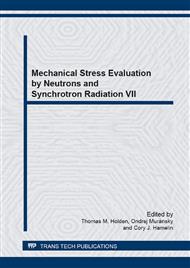p.155
p.161
p.165
p.171
p.176
p.182
p.188
p.194
p.199
Evaluation of Ductile Damage Progress of Aluminum Single Crystal with Prior Activity of Single Slip System under Tensile Loading by Using Synchrotron White X-Ray
Abstract:
A ductile damage progress of an aluminum single crystal with the prior activity of the single slip system under tensile loading was verified by a profile analysis using white X-ray obtained in BL28B2 beam line of SPring-8. In this study, the aluminum single crystal of the purity 6N was used as a specimen prepared in I-type geometry for tensile test. A notch was introduced into one side of the center of a parallel part of the specimen by the wire electric discharge machining. White X-ray beam, which has 50 μm in both height and width, was incident into the specimen on the Bragg angle θ of 3 degrees using energy dispersive X-ray diffraction technique. The specimen was deformed by elongation in the direction of 45°to [11 and [11 crystal orientations, respectively, and a diffraction profile of the white X-ray from Al220 plane was analyzed. In profile analysis, an instrumental function was defined in consideration both of a divergence by a slit and a response function peculiar to the energy dispersive method. The Gauss component of integral breadth related to non-uniform strain and the Cauchy component of integral breadth related to crystallite size were determined by eliminating the broadening by the instrumental function from the diffraction profile of white X-ray. As a result, the characteristics of ductile damage progress near the notch of the aluminum single crystal were inspected from the distribution of both non-uniform strain and dislocation density.
Info:
Periodical:
Pages:
176-181
Citation:
Online since:
February 2014
Price:
Сopyright:
© 2014 Trans Tech Publications Ltd. All Rights Reserved
Share:
Citation:


